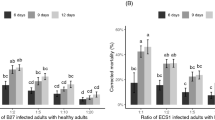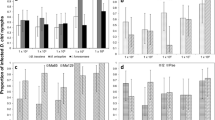Abstract
Diaphorina citri Kuwayama (Hemiptera: Liviidae) is the vector of the causal agent of Huanglongbing disease, and Toxoptera citricida Kirkaldy (Hemiptera: Aphididae) is the vector of the citrus tristeza virus. D. citri and T. citricida share the same habitat and both are susceptible to Beauveria bassiana and Isaria fumosorosea. Therefore, the aim of this study was to evaluate the horizontal transmission of B. bassiana ESALQ-PL63 and I. fumosorosea ESALQ-1296 between D. citri cadavers and uninfected D. citri adults, as well as between T. citricida cadavers and uninfected D. citri adults under laboratory and semi-field conditions. In the laboratory, the presence of one to ten D. citri cadavers infected with B. bassiana and I. fumosorosea in citrus plants resulted in mortality rates of D. citri adults ranging from 51.2 to 81.9 % and 36.2 to 68 %, respectively. When T. citricida cadavers were used, the mortality rates of uninfected D. citri adults ranged from 35.4 to 87.7 % with B. bassiana and from 41.7 to 80.4 % with I. fumosorosea. The horizontal transmission was also confirmed under semi-field conditions. The results indicate that the control of D. citri using I. fumosorosea and B. bassiana can be promoted through conidial cycling in T. citricida, by generating new infection cycles, which may contribute to the overall performance of microbial control in citrus.




Similar content being viewed by others
References
Alves SB (1998) Controle Microbiano de Insetos, 2nd edn. FEALQ, Piracicaba
Avery PB, Hunter WB, Hall DG, Jackson MA, Powell CA, Rogers ME (2009) Diaphorina citri (Hemiptera: Psyllidae) infection and dissemination of the entomopathogenic fungus Isaria fumosorosea (Hypocreales: Cordycipitaceae) under laboratory conditions. Fla Entomol 92:608–618
Avery PB, Queeley GL, Faull J, Simmonds MSJ (2010) Effect of photoperiod and host distribution on the horizontal transmission of Isaria fumosorosea (Hypocreales: Cordycipitaceae) in greenhouse whitefly assessed using a novel model bioassay. Biocontrol Sci Technol 20(10):1097–1111
Balfour A, Khan A (2012) Effects of Verticillium lecanii (Zimm.) Viegas on Toxoptera citricida Kirkaldy (Homoptera: Aphididae) and its parasitoid Lysiphlebus testaceipes Cresson (Hymenoptera: Braconidae). Plant Prot Sci 48(3):123–130
Baverstock J, Roy HE, Pell JK (2010) Entomopathogenic fungi and insect behavior: from unsuspecting hosts to targeted vectors. BioControl 55:89–102
Bové JM (2006) Huanglongbing: a destructive, newly-emerging, century-old disease of citrus. J Plant Pathol 88:7–37
Casique-Valdes R, Reyes-Martinez Y, Sanchez-Peña SR, Bidochka MJ, Lopez-Arroyo JI (2011) Pathogenicity of Hirsutella citriformis (Ascomycota: Cordicipitaceae) to Diaphorina citri (Hemiptera: Psyllidae) and Bactericera cockerelli (Hemiptera: Triozidae). Fla Entomol 94(3):703–705
FNP Consultoria & Comércio (2013) Tomada de decisão em laranjais pede cautela. In: AGRIANUAL 2013: Anuário da Agricultura Brasileira. São Paulo, pp 249–250
Demétrio CGB, Hinde J, Moral RA (2014) Models for overdispersed data in entomology. In: Godoy WAC, Ferreira CP (eds) Ecological modelling applied to entomology. Springer, Switzerland, pp 219–259
Gandarilla-Pacheco FL, Gálan-Wong LJ, Arroyo JI, Rodríguez-Guerra R, Quintero-Zapata I (2013) Optimization of pathogenicity tests for selection of native isolates of entomopathogenic fungi isolated from citrus growing areas of México on adults of Diaphorina citri Kuwayama (Hemiptera: Liviidae). Fla Entomol 96(1):187–195
García-Munguía AM, Garza-Hernández JA, Rebollar-Tellez EA, Rodríguez-Pérez MA, Reyes-Villanueva F (2011) Transmission of Beauveria bassiana from male to female Aedes aegypti mosquitoes. Parasit Vectors 4:24–29
Gravena S (2005) Manual prático de manejo ecológico de pragas dos citros. In: Gravena S (ed) As pragas. Jaboticabal, São Paulo, pp 69–220
Hajek AE, St. Leger RJ (1994) Interactions between fungal pathogens and insects hosts. Annu Rev Entomol 39:293–322
Hall DG, Hentz MG, Meyer JM, Kriss AB, Gottwald TR, Boucias DG (2012) Observations on the entomopathogenic fungus Hirsutella citriformis attacking adult Diaphorina citri (Hemiptera: Psyllidae) in a managed citrus grove. BioControl 57:663–675
Harper JD (1987) Applied epizootiology: microbial control of insects. In: Fuxa JR, Tanada Y (eds) Epizootiology of insect diseases. Wiley, New York, pp 473–496
Hernández-Torres I, López-Arroyo JI, Berlanga-Padilla A, Loera-Gallardo J, Acosta-Díaz E (2006) Efectividad de hongos entomopatógenos y vehículos de aplicación para el control del pulgón café de los cítricos Toxoptera citricida Kirkaldy (Homoptera: Aphididae). Vedalia 13(1):17–26
Hesketh H, Roy HE, Eilenberg J, Pell JK, Hails RS (2010) Challenges in modelling complexity of fungal entomopathogens in semi-natural populations of insects. BioControl 55:55–73
Hothorn T, Bretz F, Westfall P (2008) Simultaneous inference in general parametric models. Biom J 50:346–363
Hoy MJ, Singh R, Rogers ME (2010) Evaluations of a novel isolate of Isaria fumosorosea for control of the Asian citrus psyllid, Diaphorina citri (Hemiptera: Psyllidae). Fla Entomol 93:24–32
Hunter WB, Avery PB, Pick D, Powell CA (2011) Broad spectrum potential of Isaria fumosorosea against insect pests of citrus. Fla Entomol 94(4):1051–1054
Kuchment A (2013) The end of orange juice. Sci Am 308:52–59
Lezama-Gutiérrez R, Molina-Ochoa J, Chávez-Flores O, Ángel-Sahagún CA, Skoda SR, Reyes-Martínez G, Barba-Reynoso M, Rebolledo-Domínguez O, Ruíz-Aguilar GML, Foster JE (2012) Use of the entomopathogenic fungi Metarhizium anisopliae, Cordyceps bassiana and Isaria fumosorosea to control Diaphorina citri (Hemiptera: Psyllidae) in Persian lime under field conditions. Int J Trop Insect Sci 32(1):39–44
Long DW, Groden E, Drummond FA (2000) Horizontal transmission of Beauveria bassiana (Bals.) Vuill. Agric For Entomol 2:19–32
Lopes RB, Micherreff-Filho M, Tigano MS, Neves PMOJ, López EL, Fancelli M, Silva JP (2011) Virulence and horizontal transmission of selected Brazilian strains of Beauveria bassiana against Cosmopolites sordidus under laboratory conditions. Bull Insectol 64(2):201–208
Meissner Filho JO, Soares Filho WS, Velame KVC, Diamantino EP, Diamantino MSAS (2002) Reação de Porta enxerto híbridos ao Citrus Tristeza Virus. Fitopatol Bras 27:312–315
Meyer JM, Hoy MA, Boucias DG (2007) Morphological and molecular characterization of a Hirsutella species infecting the Asian citrus psyllid, Diaphorina citri Kuwayama (Hemiptera: Psyllidae) in Florida. J Invert Pathol 95:101–109
Meyer JM, Hoy MA, Boucias DG (2008) Isolation and characterization of an Isaria fumosorosea isolate infecting the Asian citrus psyllid in Florida. J Invert Pathol 99:96–102
Michaud JP (1998) A Review of the literature on Toxoptera citricida (Kirkaldy) (Homoptera: Aphididae). Fla Entomol 81(1):37–61
Moran PJ, Patt JM, Cabanillas HE, Adamczyk JL, Jackson MA, Dunlap CA, Hunter WB, Avery PB (2011) Localized autoinoculation and dissemination of Isaria fumosorosea for control of the Asian citrus psyllid in south Texas. Sub Plant Sci 63:23–35
Nielsen C, Agrawal AA, Hajek AE (2010) Ants defend aphids against lethal disease. Biol Lett 6:205–208
Padulla LFL, Alves SB (2009) Suscetibilidade de ninfas de Diaphorina citri a fungos entomopatogênicos. Arq Inst Biol 76:297–302
Pick DA, Avery PB, Hunter WB, Powell CA, Arthurs S (2012) Effect of Isaria fumosorosea (Hypocreales: Cordycipitaceae) and Lysiphlebus testaceipes, (Hymenoptera: Braconidae) on the brown citrus aphid: preliminary assessment of a compatibility study. Fla Entomol 95(3):764–766
Pinto APF, Batista Filho A, Almeida JEM, Wenzel IM (2012) Patogenicidade de Beauveria bassiana ao psilídeo Diaphorina citri e compatibilidade do fungo com produtos fitossanitários. Pesqui Agropecu Bras 47(12):1673–1680
Poprawski TJ, Parker PE, Tsai JH (1999) Laboratory and field evaluation of hyphomycete insect pathogenic fungi for control of brow citrus aphid (Homoptera: Aphididae). Environ Entomol 28:315–321
Quesada-Moraga E, Martin-Carballo I, Garrido-Jurado I, Santiago-Álvarez C (2008) Horizontal transmission of Metarhizium anisopliae among laboratory populations of Ceratitis capitata (Wiedemann) (Diptera: Tephritidae). Biol Control 47:115–124
R Development Core Team (2014) R: A language and environment for statistical computing. R Foundation for Statistical Computing, Vienna, Austria. ISBN 3-900051-07-0. http://www.R-project.org/
Sanjaya Y, Ocampo VR, Caoili BL (2013) Transmission effect of entomopathogenic fungi on population of Tetanychus kanzawai (Kishida) (Tetranychidae: Acarina). Arthropods 2(1):36–41
Sosa-Gómez DR, Alves SB (2000) Temperature and relative humidity requirements for conidiogenesis of Beauveria bassiana (Deuteromycetes: Moniliaceae). An Soc Entomol Bras 29(3):515–521
Stauderman K, Avery P, Aristizábal L, Arthurs S (2012) Evaluation of Isaria fumosorosea (Hypocreales: Cordycipitaceae) for control of the Asian citrus psyllid, Diaphorina citri (Hemiptera: Psyllidae). Biocontrol Sci Technol 22(7):747–761
Steinkraus DC (2006) Factors affecting transmission of fungal pathogens of aphids. J Invert Pathol 92:125–131
Subandiyah S, Nikoh N, Sato H, Wagiman F, Tsuyumu S, Fukatsu T (2000) Isolation and characterization of two entomopathogenic fungi attacking Diaphorina citri (Homoptera, Psylloidea) in Indonésia. Mycoscience 41:509–513
Svedese VM, Lima EALA, Figueiredo AL (2013) Horizontal transmission and effect of the temperature in pathogenicity of Beauveria bassiana against Diatraea saccharalis (Lepidoptera: Crambidae). Braz Arch Biol Technol 56(3):413–419
Toledo FR, Barbosa JC, Yamamoto PT (2006) Distribuição espacial de Toxoptera citricida Kirkaldy (Hemiptera: Aphididae) na cultura de citros. Rev Bras Frutic 28(2):194–198
Toledo J, Campos SE, Flores S, Liedo P, Barrera JF, Villaseñor A, Montoya P (2007) Horizontal transmission of Beauveria bassiana in Anastrepha ludens (Diptera: Tephritidae) under laboratory and field cage conditions. J Econ Entomol 100(2):291–297
Tsai JH, Liu YH (2000) Biology of Diaphorina citri (Homoptera: Psyllidae) on four host plants. J Econ Entomol 93(6):1721–1725
Yang Y, Huang M, Andrew G, Beattie C, Xia Y, Ouyang G, Xiong J (2006) Distribution, biology, ecology and control of the psyllid Diaphorina citri Kuwayama, a major pest of citrus: a status report for China. Int J Pest Manag 52(4):343–352
Acknowledgments
The authors would like to thank the Foundation of Citrus Growers of São Paulo State (Fundação dos Citricultores do Estado de São Paulo—FUNDECITRUS) and São Paulo State Research Foundation (Fundação de Amparo à Pesquisa do Estado São Paulo—FAPESP—IMBICONT Project number 2011/51556-3) for the financial support. The first author has a master’s scholarship provided by the Coordination for the Improvement of Higher Education Personnel (Coordenação de Aperfeiçoamento de Pessoal de Nível Superior—CAPES).
Author information
Authors and Affiliations
Corresponding author
Additional information
Handling Editor: Nicolai Meyling.
Rights and permissions
About this article
Cite this article
Conceschi, M.R., D’Alessandro, C.P., Moral, R. et al. Transmission potential of the entomopathogenic fungi Isaria fumosorosea and Beauveria bassiana from sporulated cadavers of Diaphorina citri and Toxoptera citricida to uninfected D. citri adults. BioControl 61, 567–577 (2016). https://doi.org/10.1007/s10526-016-9733-4
Received:
Accepted:
Published:
Issue Date:
DOI: https://doi.org/10.1007/s10526-016-9733-4




